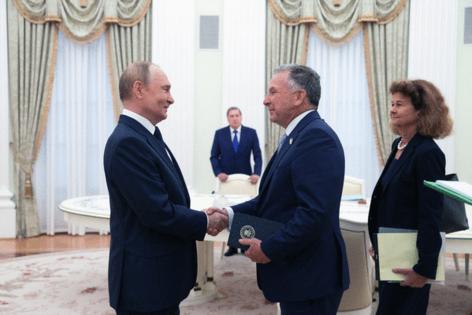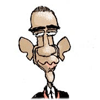Trump eyes Putin, Zelenskyy meeting as peace talks take shape
Published in News & Features
WASHINGTON — President Donald Trump told European allies he’s willing to meet with Russian President Vladimir Putin and Ukrainian President Volodymyr Zelenskyy as soon as next week in another bid to bring peace between the two countries.
Trump detailed the plans in a phone call Wednesday that also included Zelenskyy. Trump was positive about the possibilities of a ceasefire, according to several people with knowledge of the call. He also suggested that Putin would be open to entering into peace talks in exchange for discussing land swaps, the people said.
“The Russians expressed their desire to meet with President Trump, and the President is open to meeting with both President Putin and President Zelensky,” White House press secretary Karoline Leavitt said in a statement. “President Trump wants this brutal war to end.”
The effort to convene a meeting of the three leaders came hours after Putin finished hosting U.S. special envoy Steve Witkoff for three hours of discussions in Moscow. Trump in a social media post earlier on Wednesday said that there was “great progress made” in that meeting, while still leaving open the possibility of further penalties on Moscow’s oil revenues.
Secretary of State Marco Rubio said a meeting would be contingent on making enough progress toward a short ceasefire that would be used to finalize an end to the war. He acknowledged that brokering concessions around territorial control from both Russia and Ukraine would be necessary, and cautioned that there were still “many impediments to overcome” and a meeting might not come to fruition until after next week.
“I think what we have is a better understanding of the conditions under which Russia would be prepared to end the war, we now have to compare that to what the Ukrainians and our European allies but the Ukrainians primarily, of course, are willing to accept,” Rubio said in a Fox Business interview.
The Russian president has laid claim to the Ukrainian regions of Crimea, Donetsk, Luhansk, Zaporizhzhia and Kherson even though his troops don’t currently occupy the entirety of all those territories.
The U.S. had previously offered to recognize Crimea, which the Kremlin illegally annexed in 2014, as Russian as part of any deal, and to effectively cede control of parts of other Ukrainian regions that Russia occupies. As part of those earlier proposals, control over areas of Zaporizhzhia and Kherson would be returned to Ukraine.
The Middle East is one likely location for a leader-level meeting. As recently as May, during Trump’s visit to the Gulf states, Turkish President Recep Tayyip Erdogan had offered to host the leaders. Trump and Putin held a summit in person in Finland in 2018.
The New York Times first reported Trump’s plans as relayed on the call with the diplomats.
Even as the White House signaled a possible summit, the president and other officials reiterated their commitment to imposing additional tariffs on trading partners that purchased Russian energy in a bid to pressure Moscow.
“The prospect of a leader-level summit on such short notice could create unrealistic expectations at this stage,” said Samuel Charap, a senior political scientist at the global policy think tank RAND. “At best it could start a process, not finalize an agreement.”
Earlier Wednesday, Trump doubled tariffs on Indian goods to 50%, with implementation set to begin in three weeks. US officials are weighing additional actions to choke off energy sales that are a key source of funds for Russia’s war effort in Ukraine.
The Trump administration is considering new sanctions on Moscow’s covert fleet of oil tankers and several entities that enable them to operate, according to people familiar with the matter.
“Afterwards, I updated some of our European Allies,” Trump said in the post. “Everyone agrees this War must come to a close, and we will work towards that in the days and weeks to come.”
Still, a White House official said the U.S. expected to implement secondary sanctions on Friday even as they expressed satisfaction with the outcome of the Witkoff-Putin meeting.
Putin’s government said little about the three-hour conversation, with Kremlin foreign policy aide Yuri Ushakov telling reporters the Russian leader exchanged “signals” with Trump on Ukraine, without elaborating.
Oil fell for the fifth straight session as traders waited to see whether Trump would impose more severe measures to restrict Russian energy flows.
West Texas Intermediate dipped 1.2% to settle just above $64 a barrel, notching the longest daily losing streak since September, as traders positioned for the possibility of a softer stance on Russia than the White House had previously telegraphed.
Futures dipped further after reports that Trump plans to meet Putin in person as soon as next week.
The Russian vessels have become instrumental to its ability to move its oil despite U.S. and European sanctions.
“The shadow tanker fleet is the backbone of Russia’s sanctions evasion and war financing,” Andriy Yermak, Zelenskyy’s chief of staff, said on the X platform.
The Financial Times first reported the potential measures on Russia’s shadow fleet.
The people said the Trump administration is considering a range of options to restrict Putin’s energy revenues. Other possibilities could include measures targeting oil companies and actions to better enforce existing restrictions.
______
(With assistance from Catherine Lucey, Gregory White, Kate Sullivan, Tony Halpin, Eric Martin and Annmarie Hordern.)
___
©2025 Bloomberg L.P. Visit bloomberg.com. Distributed by Tribune Content Agency, LLC.







Comments